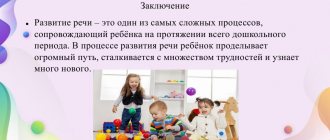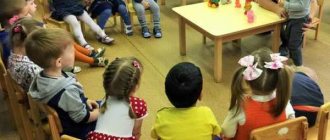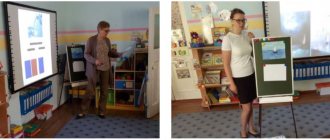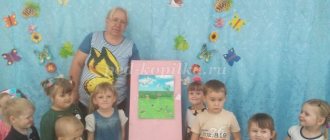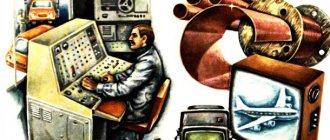Summary of educational activities on cognitive development in the early age group
Summary of educational activities for cognitive development in the early age group “Bunny visiting the children”
Tasks:
1. Contribute to the formation in children of an initial interest in knowledge.
2. To promote the development of children’s ability to independently compose a set, highlighting each individual element in it.
3. Strengthen the ability to distinguish between one and many objects; knowledge of geometric figures.
4. Improve ideas about the properties of objects: color, shape, size.
5. Practice grouping objects by color, shape, size.
6. Encourage children to name objects and their characteristics.
7. To promote children’s development of attention, mental operations, children’s ability to communicate with peers and adults, and to engage in joint play activities.
8. Foster independence, activity, and the ability to work in a group.
Vocabulary work: many, one, big, small.
Tools: bunny toy, large triangle, square, circle shapes, a set of small shapes (triangle, square, circle, large and small balls, large and small box, cookies.
GCD
Educator: Guys, look how many guests came to our group! Let's say hello to the guests and smile at them.
Children: Hello.
Educator: Guys, look, who is sitting among the guests? ( bunny )
. Let's say hello to him too.
(Children say hello to the bunny )
Educator: Guys, the bunny says that he came to visit us and brought us a gift. But to get it you need to complete the tasks that the bunny has prepared for you. Do you agree to implement them?
Children: Yes.
Educator: Then let’s sit down on the chairs and start working. Look here are the figures. Let's name them. What kind of figure is this? (square)
What colour is he?
(Yellow)
What kind of figure is this?
(triangle, blue)
And this?
(circle, red)
.
Educator: Look, there are still figures here.
Now I will give them to you, and you look carefully and find a house that looks like them.
Educator: Take turns, come up and put the figure in your house (children lay out the figures, while naming the figure in their hands.)
Educator: Well done, guys. We completed the task. All the figures are in their own houses.
And the Bunny is very happy. Now let's take a little rest.
Outdoor game: “The gray bunny is sitting”
.
The little gray bunny sits and wiggles his ears,
Like this, like this, he moves his ears.
(They squat down and move their hands above their heads.)
It's cold for the bunny to sit - we need to warm his paws,
(They stand up, stroke the other with one hand, then vice versa.)
It’s cold for the bunny to stand - the bunny needs to jump,
Like this, like this - the bunny needs to jump.
(Press your hands to your chest (like paws)
and jump on the spot.)
Educator: Have you rested? Now, let’s continue to carry out the bunny’s tasks. Look what we have here? (balls)
.
How many balls are there? (A lot of)
.
What size are they? (Big and small)
.
Right. Let's take a ball. Lisa, how many balls do you have in your hand? (one)
.
What about Zhenya? (one)
.
And Artem has one, and Artem has one. There are two boxes here, what size are they? (large)
.
And this? (small)
. Now let's put the balls in boxes: we will put large balls in the large one, and small ones in the small one.
(In the process of putting the balls into boxes, the teacher asks the children about the size of the ball and its color.)
Educator: What a great fellow you are, guys. The bunny is very glad that you completed his tasks and wants to give you gifts. Look, what is this? (cookie)
.
(The teacher distributes cookies to the children)
.
Educator: Now the bunny needs to go home to the forest, let's say goodbye to him.
(Children say goodbye to the bunny )
.
Reflection.
Educator: Guys, did you like completing the tasks? What did we do? Did you like the gifts? You worked so well today. Well done!
MAGAZINE Preschooler.RF
“It is impossible to teach a person to be happy, but you can raise him so that he is happy.” Makarenko A. S. Early age is rightly considered the time of formation of intellectual and creative abilities. Science and practice recognize the uniqueness and originality of early age, when the count is not in years, not in months, but in weeks and even days. It is in the first three years that 80% of the physical, moral and intellectual foundation of the individual is laid. Psychologists believe that the highest potential for creative development is from 2 to 3 years. During this time, the child goes through a huge path in his development. He learns to see the world, understand the meaning of surrounding objects, communicate with people, speak and much, much more. It is in the first years that his attitude towards people, towards himself, towards the world is formed. First childhood impressions leave an indelible imprint on a person’s future life. After all, here is the beginning of all his future qualities and abilities. What a child does not receive in early childhood is very difficult, and sometimes impossible, to compensate for at a later age. Therefore, the first three years of life are an extremely important and responsible stage, which largely determines the further development of a person. The main tasks of raising and educating young children are maintaining the child’s health, full physical development, development of speech, play activities, sensory development, the formation of basic mental processes, and the development of mental cognitive and creative abilities. Health-improving orientation of the educational process: the use of breathing exercises and a set of exercises to protect vision during routine moments; strict monitoring of children's development, which helps to timely detect developmental delays and organize an individual approach; use of techniques of surprise, entertainment, and clarity when organizing GCD; creating conditions for a positive emotional state of children. Ensuring the psychological safety of a child’s personality involves: creating a subject-specific developmental environment appropriate for age; regime variability; variety of everyday life; correct organization of communication (exclusion of authoritarian style); the use of musical breaks and psycho-gymnastics techniques; strict dosing of loads; development of programs for psychological and pedagogical support of children's development (comprehensive); elimination of intellectual, physical and psycho-emotional overloads through rational construction of the life activity regime of young children. Treatment and preventive work, which includes: careful care for children; developing their cultural and hygienic skills; organization of hardening, sleep. Social, pedagogical and psychological support for families is provided by: organizing work with children who have difficulty adapting; organizing parental consultations in order to familiarize adults with the age characteristics of children and teach parents how to interact with young children. The most important mechanism for the full development of personality from early childhood is a variety of activities of the child: communication, play, movement, work, design, drawing. At different age stages, certain types of activities act as leading ones. Early age is the period of the most intensive assimilation of ways of acting with objects. By the end of this period, thanks to cooperation with an adult, the child basically knows how to use household objects and play with toys. Objective activity and its role in the development of the child Objective activity is leading because it is in it that the development of all aspects of the child’s psyche and personality occurs. First of all, it must be emphasized that in the child’s objective activity the development of perception occurs, and the behavior and consciousness of children of this age is entirely determined by perception. Thus, memory at an early age exists in the form of recognition, i.e. perception of familiar objects. The thinking of a child under 3 years of age is predominantly immediate – the child establishes connections between perceived objects. He can only be attentive to what is in his field of perception. All the child’s experiences are also focused on perceived objects and phenomena. Since actions with objects are aimed mainly at their properties such as shape and size, these are the characteristics that are most important for the child. Familiarization with the environment Young children early develop an interest in the phenomena of social life, which the teacher, if possible, should try to satisfy. Various objects are selected for games, for example, a cup, saucer, mug and teapot. On the instructions of the teacher, children perform various actions with these objects: drink a doll from a mug, pour tea into it from a teapot, etc. While learning about the world around them, the child learns verbal designations of objects and phenomena of reality, their properties, connections and relationships. When developing speech, you need to take care not so much that the baby pronounces as many words as possible, but that the words that he hears and repeats are filled with specific content for him. Therefore, the work on forming a vocabulary should be closely related to the work on familiarizing oneself with the environment. By inviting children to participate in dramatizations and dramatizations of passages from works of fiction, I encourage them to repeat sentences that are different in structure. In enriching the child with new ideas and developing speech, didactic games play a large role - in developing orientation in the environment, in developing attention; to distinguish the color and shape of objects: “Build a sun”, “What’s in the box?”, “Who’s eating what?”, “Where are we?” (a doll is sitting, books are lying); “Find out who called”, “Tell me what it sounds like”, etc. - for the development of breathing: “Blow on a snowflake” (a twig with leaves, a floating boat) Children gain their first knowledge about ecology by observing changes in corners of nature. Visual activities Children develop an interest in drawing early. The first organized introduction of a child to visual arts begins in kindergarten, in the first junior group (third year of life). When conducting educational activities in the first junior group, you cannot impose the same requirements on everyone. The main thing is to cultivate an interest in visual arts, a desire to try one’s strengths, and to instill the skills of certain behavior in the process of practicing and handling materials. It is necessary to teach children to sit up straight, without bending too much over the table, to draw with their right hand, and hold a sheet of paper with their left. But verbal instructions alone are not enough for the baby: first, everyone needs to be helped to sit down correctly and place their hands correctly. The child’s muscles are still very weak, especially the extensor muscles, so very soon children will begin to bend over the table, and the teacher must correct their posture again and again. When organizing work on visual arts in the first junior group, it is necessary to take into account the greater emotional excitability of children of this age. You need to speak softly with children and formulate instructions in the form of a proposal, and not a categorical demand.Water and sand centers, corners for experimental activities in our group were created to organize research work with children, which is aimed at developing a child’s curiosity from the first years of his life. There are scoops, various molds, and sets of rubber toys. Children get acquainted with the properties of various objects and materials, consolidate ideas about the shape, size, color of objects, and develop fine motor skills.
The role of music in relieving psycho-emotional stress in children is very great. By introducing a child to music from early childhood, we develop not only immediate musical abilities, but also emotional sensitivity, a desire for beauty, and a deeper understanding of the world. Our group has CDs with music for children, with songs from children's movies and cartoons, dance melodies, lullabies.
Thus, in the first three years of life, the most important and fundamental human abilities are laid - cognitive activity, curiosity, self-confidence and trust in other people, focus and perseverance, imagination, creativity and much more. Moreover, all these abilities do not arise on their own, as a consequence of the child’s small age, but require the indispensable participation of an adult and age-appropriate forms of activity.
“Every moment of that work called education is a creation of the future and a look into the future.”
| Next > |
